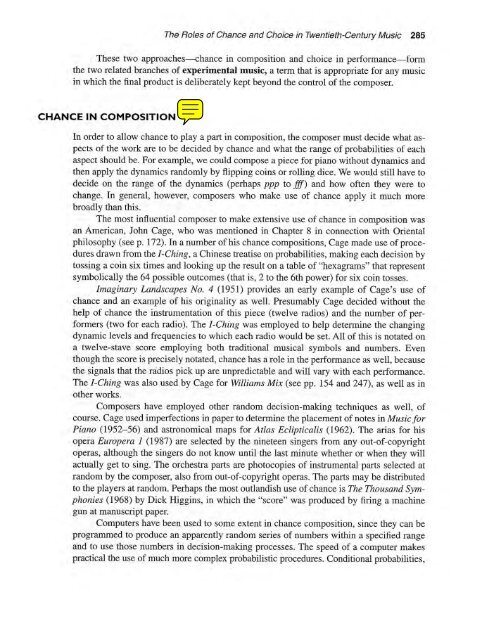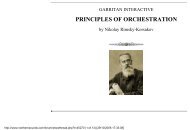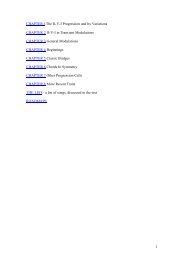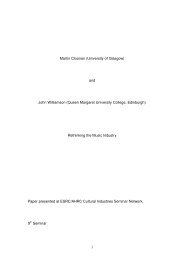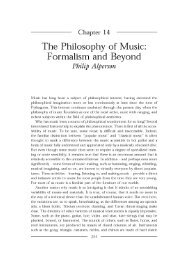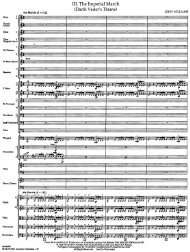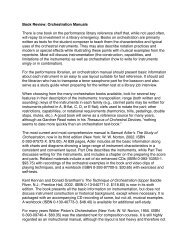TWENTIETH- - Synapse Music
TWENTIETH- - Synapse Music
TWENTIETH- - Synapse Music
Create successful ePaper yourself
Turn your PDF publications into a flip-book with our unique Google optimized e-Paper software.
The Roles of Chance and Choice in Twentieth-Century <strong>Music</strong> 285<br />
These two approaches---chance in composition and choice in performance- form<br />
the two related branches of experimental music, a term that is appropriate for any music<br />
in which the final product is deliberately kept beyond the control of the composer.<br />
CHANCE IN COMPOSITION<br />
In order to allow chance to playa part in composition, the composer must decide what aspects<br />
of the work are to be decided by chance and what the range of probabilities or each<br />
aspect should be. For example, we could compose a piece for piano without dynamics and<br />
then apply the dynamics randomly by flipping coins or rolling dice. We would still have to<br />
decide on the range of the dynamics (perhaps ppp to iff) and how often they were to<br />
change. In general, however, composers who make use of chance apply it much more<br />
broadly than this.<br />
The most influential composer to make extensive use of chance in composition was<br />
an American, John Cage, who was mentioned in Chapter 8 in connection with Oriental<br />
philosophy (see p. 172). In a number of his chance compositions, Cage made use of procedures<br />
drawn from the I-Ching, a Chinese treatise on probabilities, making each decision by<br />
tossing a coin six times and looking up the result on a table of "hexagrams" that represent<br />
symbolically the 64 possible outcomes (that is, 2 to the 6th power) for six coin tosses.<br />
Imaginary Landscapes No.4 (1951) provides an early example of Cage's use of<br />
chance and an example of his originality as well. Presumably Cage decided without the<br />
help of chance the instrumentation of this piece (twelve radios) and the number of performers<br />
(two for each radio). The I-Ching was employed to help determine the changing<br />
dynamic levels and frequencies to which each radio would be set. All of this is notated on<br />
a twelve-stave score employing both traditional musical symbols and numbers. Even<br />
though the score is precisely notated, chance has a role in the performance as well, because<br />
the signals that the radios pick up are unpredictable and will vary with each performance.<br />
The I-Ching was also used by Cage for Williams Mix (see pp. 154 and 247), as well as in<br />
other works.<br />
Composers have employed other random decision-making techniques as well, of<br />
course. Cage used imperfections in paper to determine the placement of notes in <strong>Music</strong> for<br />
Piano (1952-56) and astronomical maps for Atlas Eclipticalis (1962). The arias for his<br />
opera Europera 1 (1987) are selected by the nineteen singers from any out-of-copyright<br />
operas, although the singers do not know until the last minute whether or when they will<br />
actually get to sing. The orchestra parts are photocopies of instrumental parts selected at<br />
random by the composer, also from out-of-copyright operas. The parts may be distributed<br />
to the players at random. Perhaps the most outlandish use of chance is The Thousand Symphonies<br />
(1968) by Dick Higgins, in which the "score" was produced by firing a machine<br />
gun at manuscript paper.<br />
Computers have been used to some extent in chance composition, since they can be<br />
programmed to produce an apparently random series of numbers within a specified range<br />
and to use those numbers in decision-making processes. The speed of a computer makes<br />
practical the use of much more complex probabilistic procedures. Conditional probabilities,


